Home » What’s the Best Bra Size Calculator? 8 Calculators Compared
What’s the Best Bra Size Calculator? 8 Calculators Compared
In this article, we will review and compare 8 different bra size calculators. They vary a great deal in the information they gather and the algorithm they use to suggest a size. We will explore these differences, with a goal of understanding the factors that go into estimating your bra size.
For convenience of discussion, we will break down sizes into four groups: small band small cup, small band big cup, big band small cup, big band big cup.
Very roughly,
small cup = 5 inches or less difference between band and bust (A-DD cup)
small band = 38’’ and smaller ribcage
big cup = 6 inches or more difference between band and bust (DDD cup and up)
big band = 38’’ and up ribcage
1. Pepper – Simple Plus 4
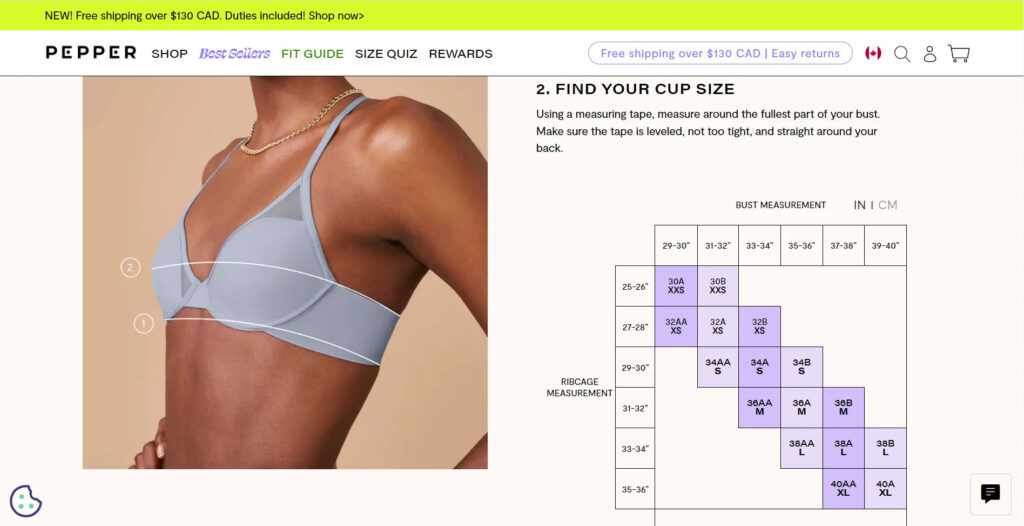
Pepper uses what’s known as the “plus 4” method. They add 4 inches to your snug band measurement.
Pros: This size calculator is clearly designed for small band small cup, which is Pepper’s niche. It suggests a good starting point for bra wearers with very little tolerance for ribcage tightness. The band will lightly graze your body without feeling constricting in the slightest.
Cons: This calculator will not work for small band big cup, big band big cup, or big band small cup – the three size groups that need support in addition to coverage. In those cases, the calculator will suggest too big a band size, and too small a cup size. If you suffer from back and shoulder pain from bad bras, your breasts need to be lifted. To achieve this, your bra needs a good foundation (a snug band).
2. The Little Bra Company – Simple Plus 2
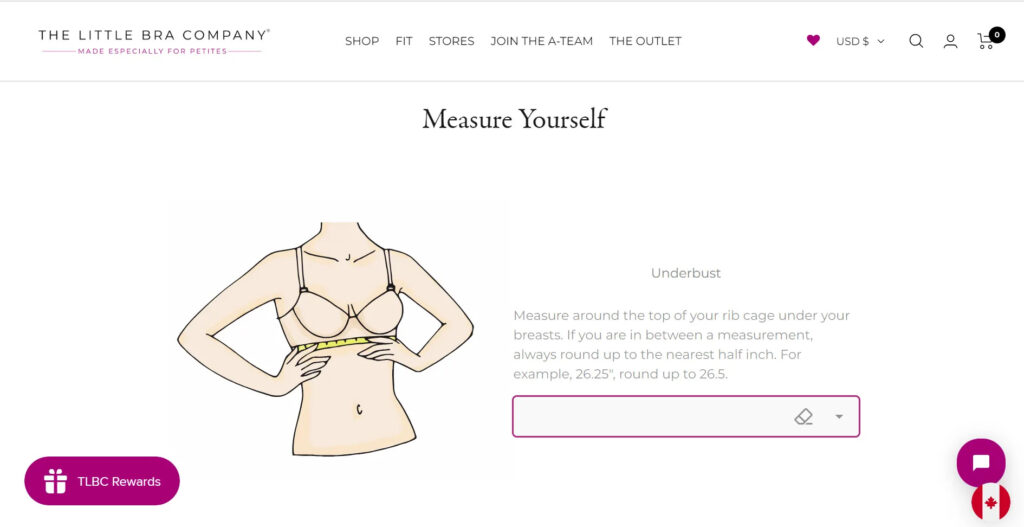
Compared to Pepper’s size calculator, which serves the same size niche, the Little Bra Company’s size calculator will give you a smaller band number and a bigger cup letter. For example, if Pepper’s calculator gives you 32B, TLBC will give you 30D.
Pros: It suggests a good starting point for small band small cup, which is the TLBC’s niche. It cuts the difference between a firm and lifting fit, and a relaxed, completely non-binding fit.
Cons: This calculator has a tendency to produce a too-big cup size. People with a less than 5-inch difference between band and bust tend to have a lot of space between their breasts, which makes size calculators overestimate cup size. Given that the calculator already collects information about your breast spacing, it seems like an easy adjustment to incorporate this information into size calculation.
3. Bare Necessities – Simple Plus 0
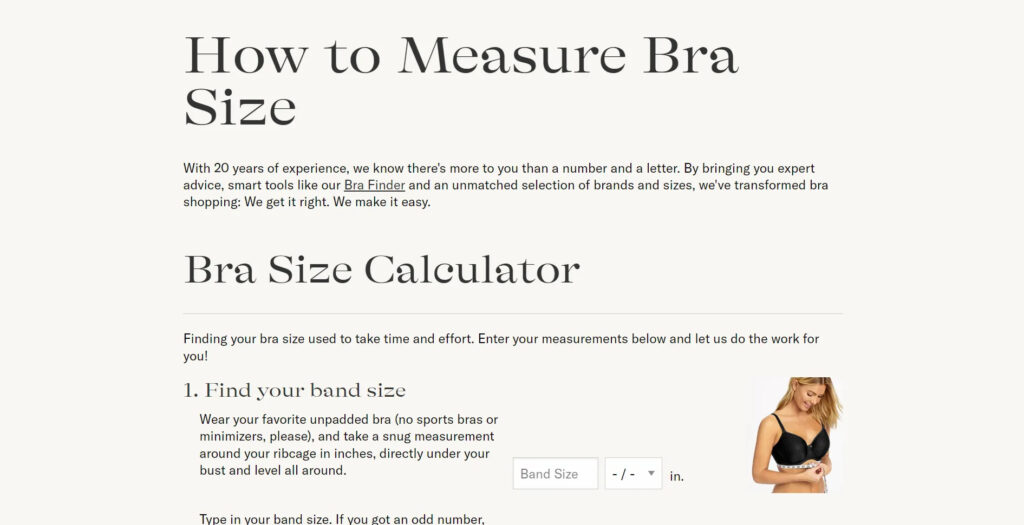
Pros: Bare Necessities carries many brands in an impressive size range (28-58, A-J). A plus 0 algorithm is a good starting place, all sizes considered. It works better for small band big cup, and big band big cup.
Cons: Taking only one bust measurement is unlikely to produce an accurate result for most, especially for those with relaxed breasts. If your breasts are at waist level without a bra on, it’s impossible for the measuring tape to encapsulate their full volume while you are standing. Measuring with an unpadded bra doesn’t really solve the problem, because you are really measuring the bra, not your breasts.
4. Victoria’s Secret – Plus 0 with a Twist
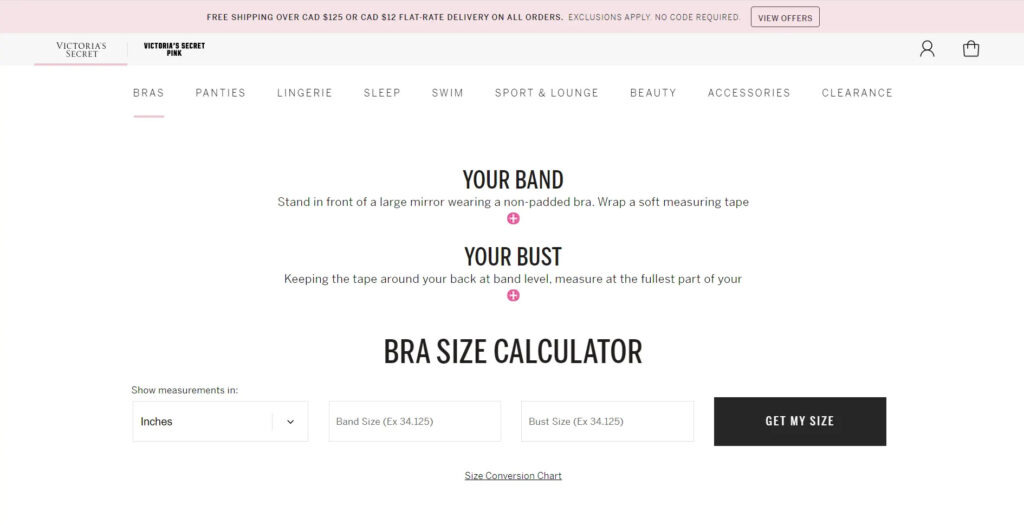
From here, it’s a plus 0 algorithm with a twist. Up to a 40’’ band measurement, it adds 0 inches. At 40’’ and up, it’ll actually subtract 2 inches from your band. So if your band measurement is 44’’, it’ll suggest a band size of 42. The calculator stops returning results when you band and bust differ by more than 7 inches, or a G cup.
Pros: Measuring band size above the bust will inflate band size significantly. Though this calculator, at first glance, uses a plus 0 algorithm, it’s really closer to plus 4. It will return a result that is similar to Pepper’s. If you have no tolerance for any ribcage tightness and don’t require much support, Victoria’s Secret’s size calculator can suggest a workable starting point. Also, it’s generally a good idea to use a graduated approach to sizing. In our experience, customers who measure 40+ inches often fit a smaller band size than their plus 0 size, so taking inches off here will return more accurate results.
Cons: We are not sure why this calculator asks you to measure band size above the bust – which is not where the bra band sits. For any size range other than small band small cup, this calculator will likely suggest a size that doesn’t offer a lot of support.
5. A Bra That Fits – Sophisticated Plus 0
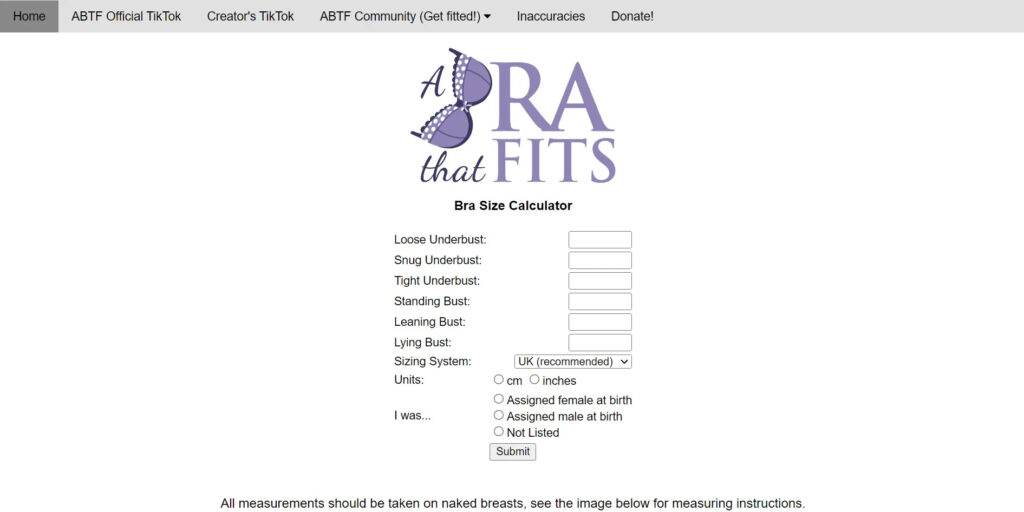
The ABTF calculator algorithm is a quite complex version of plus 0. For band size, it primarily depends on the snug measurement. If snug and tight are very close together, the calculator assumes you are more muscular or bony, and will suggest sizing up in the band for ribcage comfort. If loose and tight are very far apart, the calculator assumes you have more “squish,” and will suggest sizing down in the band for more support.
For bust, when standing and leaning bust are close together, the calculator assumes you are self-supported or have firm breast tissue, in which case it will rely on the leaning measurement. When standing and leaning are far apart, it assumes your breasts are relaxed or have soft breast tissue, in which case it’ll take an average of standing, leaning, and lying, which will bring down the cup size.
For people who check the AMAB box, the calculator takes a weighted average of all three bust measurements, counting standing and lying twice, and leaning once. The calculator assumes you have a more V-shaped ribcage and more conical breast tissue, which usually implies a smaller cup size.6
Pros: This is one of the best bra size calculators overall. The six measurements contain a lot of information about your shape, and the calculator puts it to good use. It’s the most likely to lead you to a technically perfect fit (which is the most comfortable fit for those looking for maximum support, but not for those who want a relaxed bra).
Cons: This size calculator tends to overestimate cup sizes for bigger bands (more than 38”), especially for big band small cup – sometimes suggesting more than 3 cup sizes too big. The sizing algorithm assumes everything the measuring tape picks up in the bust measurements is breast tissue. But back fat and underarm fat can inflate bust measurements, as well as empty space between breasts.
6. Wacoal – From Plus 4 to Minus 4
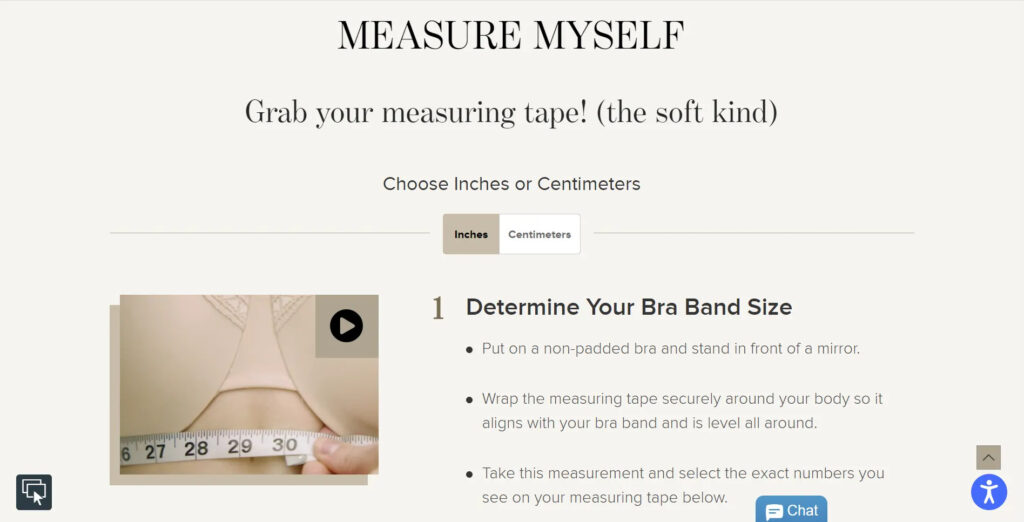
Its algorithm takes a graduated approach to band sizes, adding inches for petite and taking off inches for plus-size. For 32 and below, it uses plus 4; 34-38, plus 2; 40-44, plus 0; 46-48, minus 2; and 50, minus 4.
For cup sizes, the Wacoal calculator doesn’t do the usual 1’’ = A, 2’’ = B, 3’’ = C, etc. The calculator “skips” a cup size when you enter 30 and 35 (34B), and 30 and 36 (34D). The same thing happens when you enter 40 and 47 (40DD), and 40 and 48 (40G). It artificially reduces cup sizes when you have a smaller difference between band and bust, for all band sizes.
Pros: Having a graduated algorithm for different size groups will certainly improve the accuracy of results. This calculator works well for small band small cup, big band small cup, and big band big cup.
Cons: We don’t love this calculator for small band big cup. For example, if you measure 30 for band and 40 for bust, the calculator suggests 34H, which will be too loose in the band to provide the level of support this size range typically needs.
7. Thirdlove – No Measuring Tape Needed
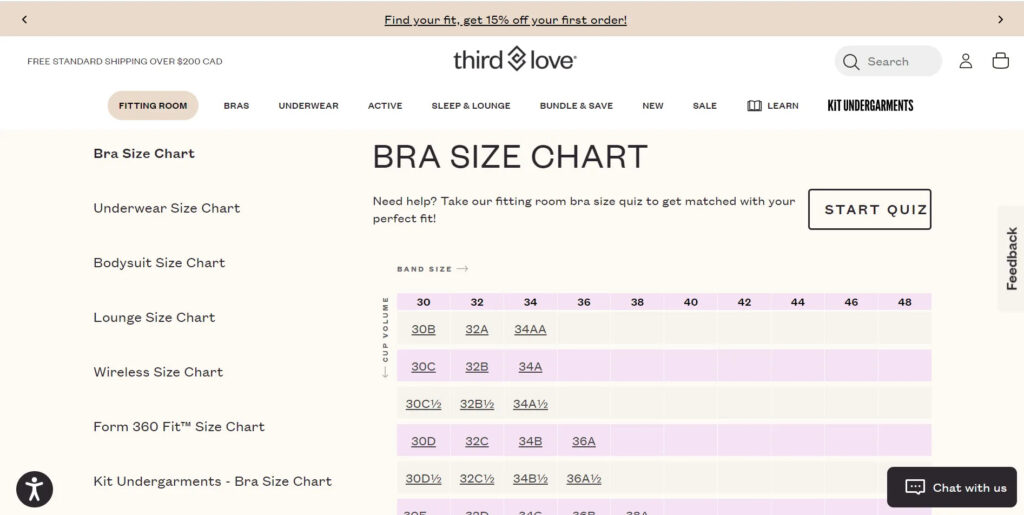
Instead of your measurements, Thirdlove’s calculator asks for your current bra size (and brand), then asks you fit questions in order to tweak it. The questions include if your shoulder straps slip or dig, if your cups overflow or gap, which set of hooks you are on, and asks you to choose from one out of 8 breast shapes (athletic, bell, east west, relaxed, round, side set, slender, teardrop).
Pros: Thirdlove’s size calculator doubles as a troubleshooting guide and a size comparison guide across some brands. It’s also convenient to not need a measuring tape.
Cons: This calculator is usable if you are wearing a bra size that isn’t too far off. If you are starting from scratch or never had a properly fitted bra to begin with, this calculator won’t be much help. It usually suggests not more than 1 cup size and 1 band size off from your current size.
8. Understance – Personal Preference First
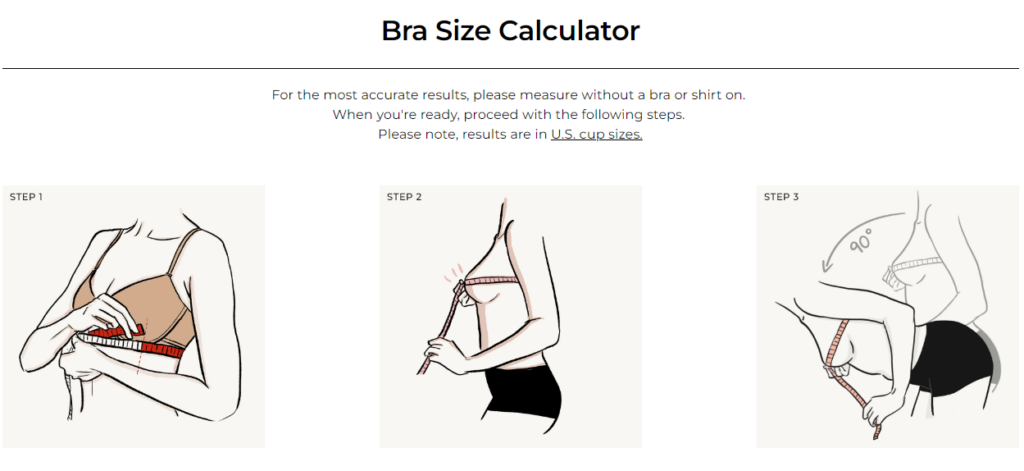
For band measurement, we ask that you imagine the measuring tape is your bra band, and pull it as snugly as you want your bra to fit. Because band size is the (literal) foundation of the bra, where there is the most room for debate, we decided to leave it up to the person using the calculator. Depending on your preference, it can be loose, snug, or tight.
For bust measurement, we take standing and leaning (no bra on). The calculator uses their average for cup size. For 40 and 42 band, we take off a cup size. For 44, we take off two cups. For 46 and 48, we take off three.
The breast spacing question will add a cup if you check “very center-full,” and take off a cup if you check “very side-set.”
Finally, if you choose “firm fit,” you will get your plus 0 size. If you choose “relaxed fit,” you will get the sister size up.
Pros: Our calculator maximizes the weight of your personal preference.
Cons: Our calculator has a tendency to suggest too big a cup size for “relaxed fit.” We suspect that if you can’t tolerate a tight band, some of the support has to come from the compression in the cups, so your “relaxed fit” isn’t the sister size up, but rather a sister size up, then a cup size down. (We will continue to collect data, and tweak if there is enough evidence.)
Leaving your band measurement snugness to personal preference can be a bit tricky. If you’ve never had a properly fitted bra and don’t know that a tight band can be your friend, you may miss out on trying a size that can save you from back pain.
We chose these 8 calculators to represent different schools of thought when it comes to bra sizing. With this information, we hope that you can make the most out of online bra size calculators no matter where you shop.
References:
1. How to Measure Bra Size. Pepper. https://www.wearpepper.com/pages/how-to-measure-bra-size
2. Fit Calculator. The Little Bra Company. https://www.thelittlebracompany.com/pages/fit-calculator
3. How to Measure Bra Size. Bare Necessities. https://www.barenecessities.com/feature.aspx?pagename=fit_sizing
4. HOW TO MEASURE YOUR BRA SIZE. Victoria’s Secret. https://www.victoriassecret.com/ca/vs/bras/how-to-measure-bras
5. Bra Size Calculator. A Bra That Fits. https://www.abrathatfits.org/calculator.php
6. Deep dive into the A Bra That Fits calculator | an interview with the creator of the calculator. YouTube. https://www.youtube.com/watch?v=3jZeCSiEckM
7. MEASURE MYSELF. Wacoal. https://www.wacoal-america.com/DigitalFitQuestionnaire
8. BRA SIZE CHART. Thirdlove. https://www.thirdlove.com/en-ca/pages/bra-size-chart
9. Fitting Room. Thirdlove. https://www.thirdlove.com/en-ca/pages/fitting-room
10. Bra Size Calculator. Understance. https://understance.com/size-calculator
